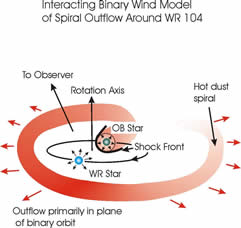Could WR 104 Threaten Earth?
By Greg Bryant
January 7, 2008 :
The
binary system known as WR 104, which consists of a Wolf-Rayet star and
an OB companion, is well known for its spectacular dusty “pinwheel”
nebula, which was revealed in spectacular detail by a team of
astronomers lead by Peter Tuthill (now at Sydney University) in 1999.
The nebula is formed by material contained within a wind that is driven
away from the binary stars. As the material moves away from the stars,
it curves as it rotates around the system.
That same team, expanded to include others from
Australia and the United States, has now compiled observations (taken
with the 10 metre Keck Telescope in Hawaii) of WR 104 spanning six
years (their study is to be published in the Astrophysical Journal). Wolf-Rayet stars are candidates for turning into supernovae, and so their mass-loss history is of considerable interest.
Recent studies of supernovae have explored whether
there is a link between these exploding stars and gamma-ray bursts (the
most energetic events known in the Universe). In the case of WR 104, it
is possible that when the Wolf-Rayet star explodes, much of the energy
and matter will be ejected at the polar ends – and Earth is virtually
pole-on to the system.
Our understanding of the connection between
supernovae and gamma-ray bursts is still in its infancy, but Tuthill
and his colleagues suggest that there is a possibility that WR 104
might produce a gamma-ray burst – one that would be only 7,000
light-years from us (as good as on our doorstep).
The good news is that we probably have several hundred thousand years before the Wolf-Rayet star in question does explode.
|
|

This
image, taken with the Keck 1 Telescope at Mauna Kea, shows the extent
and curvature of the nebula around the binary system WR 104. The
diameter of the spiral is some 160 astronomical units. U.C. Berkeley Space Sciences Laboratory/W.M. Keck Observatory

This diagram details the components of the WR 104 system, and the near pole-on view that Earth “enjoys”. P. Tuthill (University of Sydney)
|


